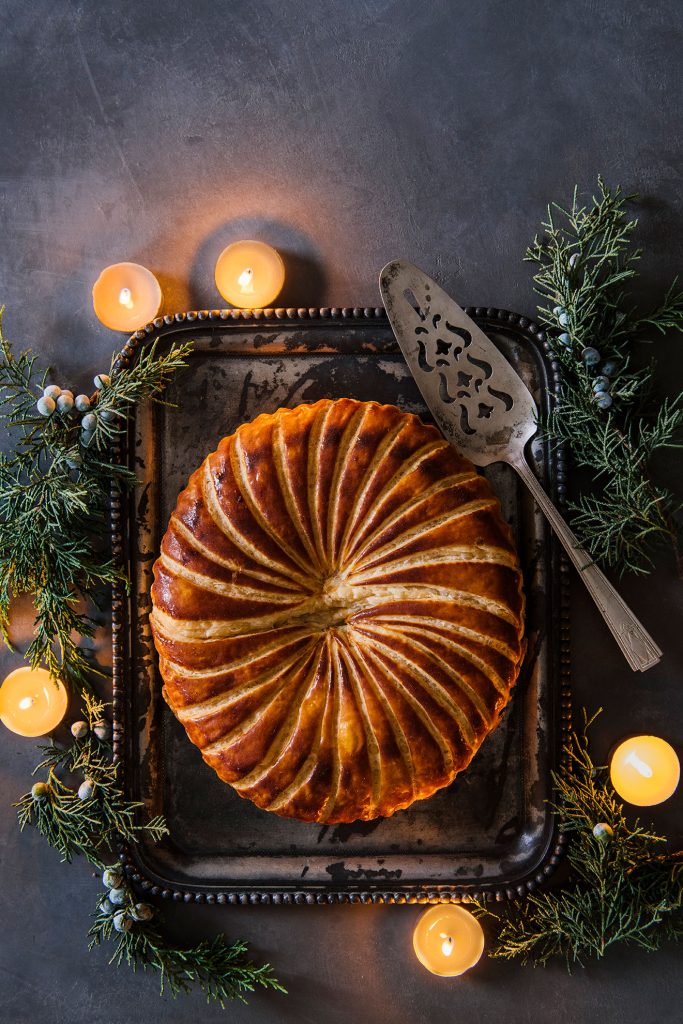
January is usually a quiet month for us after all of the celebrating in November and December. Our big baking treat of the month is this stunningly beautiful French King Cake. It is traditionally made in celebration of the Christian feast day, Epiphany or Three Kings’ Day. We make ours with buttery layers of puff pastry (now made with freshly milled whole grains!), filled with almond frangipane. We decorate it with curved spiral lines on top and a scalloped edge, in a semblance of a king’s crown. Also known as le pithviers, this cake derives its French name from the town Pithviers. This Central-Val de Loire region of north-central France, is where it is thought to have originated.
The Epiphany
Observed by Orthodox, Catholic, and Anglican Christians, Epiphany, falls on the twelfth day after Christmas. It commemorates the Biblical story of the “Magi” or “Wise Men” or “Kings.” These noble pilgrims from the East followed a miraculous guiding star to Bethlehem. They bared gifts of gold, frankincense, and myrrh, and paid homage to the infant Jesus as king of the Jews and the Son of God on the twelfth night after his birth. A King Cake, thus takes its first star turn on January 6, the Feast Day of Epiphany or Twelfth Night, in honor of the Magi’s holy pilgrimage. It’s enjoyed again throughout the Carnival season right up through Mardi Gras or Fat Tuesday. It takes a final bow on the last day before Ash Wednesday, when the season of Lent begins.
A cake fit for a king
The tradition of celebrating Epiphany with a King Cake is thought to have originated in Medieval Europe. Since then, the cake has taken on many different guises. In England, it is known as a Twelfth Night cake, the Portuguese call theirs Bola-Rei, and the Spanish make Rosca de Reyes. In France, the le pithviers-style King Cake is known as the Galette De Rois. First mentioned in the 14th century, the cake soon gained popularity throughout France and remains so to this day.
There is an age-old French game, known as tirer les rois (find the king) that is played, around the hidden trinket, nut, or bean tucked inside the cake. Families cut the King Cake so that each person has a slice with one extra for the symbolic ‘poor passerby.’ To ensure fair play, the youngest member of the family then ducks beneath the table, and with a blind eye, dictates who gets which slice. The lucky one who finds the trinket in their slice (if they don’t up and swallow it!), is crowned king or queen and is given free rein to rule the roost the rest of the day.

From Europe, the King Cake as an Epiphany and Mardi Gras tradition made its way across the Atlantic to the New World by the late 17th century. Historians believe that the festivities of Carnival were brought to Louisiana by the French-Canadian explorer, Pierre Le Moyne d’Iberville (1661-1706), while leading an expedition on behalf of the French crown to find the main channel of the Mississippi River into the continent. Traveling up the Mississippi in March of 1699, he and his fellow explorers set up camp along the east bank of the river, about 60 miles south of present-day New Orleans. Their stop on the river fell on Fat Tuesday, prompting Pierre to dub the spot Pointe du Mardi Gras. So began the first Carnival celebrations in Louisiana along the Lower Mississippi River around New Orleans.
Join in the tradition
Both elegant and festive (and delicious!), we make this cake every year from January 4th through 6th. Pick one up and start your own Epiphany tradition to keep the good holiday times rolling just a little bit longer. Or, make it yourself! Enjoy a baking project? Get your hands on our new cookbook, Celebrate Every Day, for the recipe.
Hungry for more?
- Order a King Cake for pick up at the Bakeshop. Call 734-761-2095 to reserve yours today!
- Join us at BAKE! to learn to make King Cake from scratch. (Class full? Add your name to the waitlist and we’ll call you if space opens up!)
- Get the recipe in our cookbook, Celebrate Every Day.
After a long, established career as a Ph.D. art history scholar and art museum curator, Lee, a Michigan native, came to the Bakehouse in 2017 eager to pursue her passion for artisanal baking and to apply her love of history, research, writing, and editing in a new exciting arena. Her first turn at the Bakehouse was as a day pastry baker. She then moved on to retail sales in the Bakeshop, followed by joining the Marketing Team and becoming the Bakehouse’s designated culinary historian. In addition to her retail sales and marketing work, she’s a member of the Bakehouse’s Grain Commission, co-author and editor of the Bakehouse's series of cookbooklets, and a regular contributor to the BAKE! Blog and Zingerman’s Newsletter, where she explores the culinary, cultural, and social history and evolution of the Bakehouse’s artisan baked goods.



